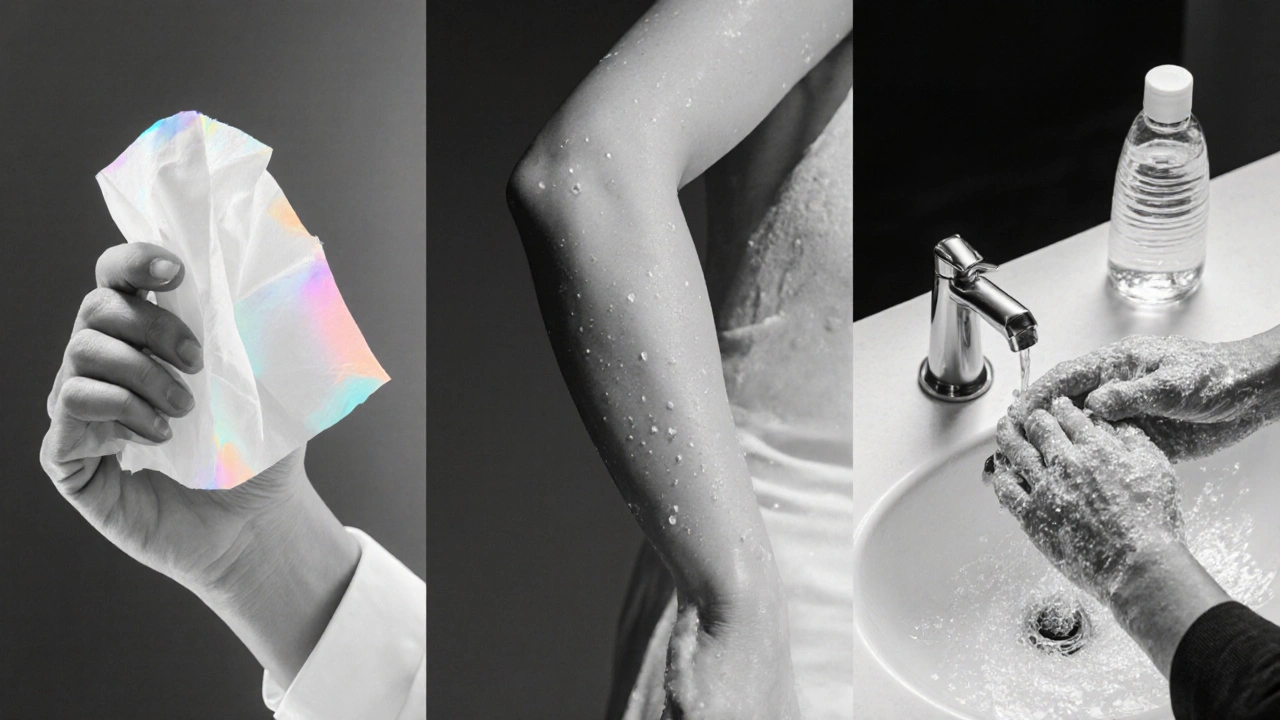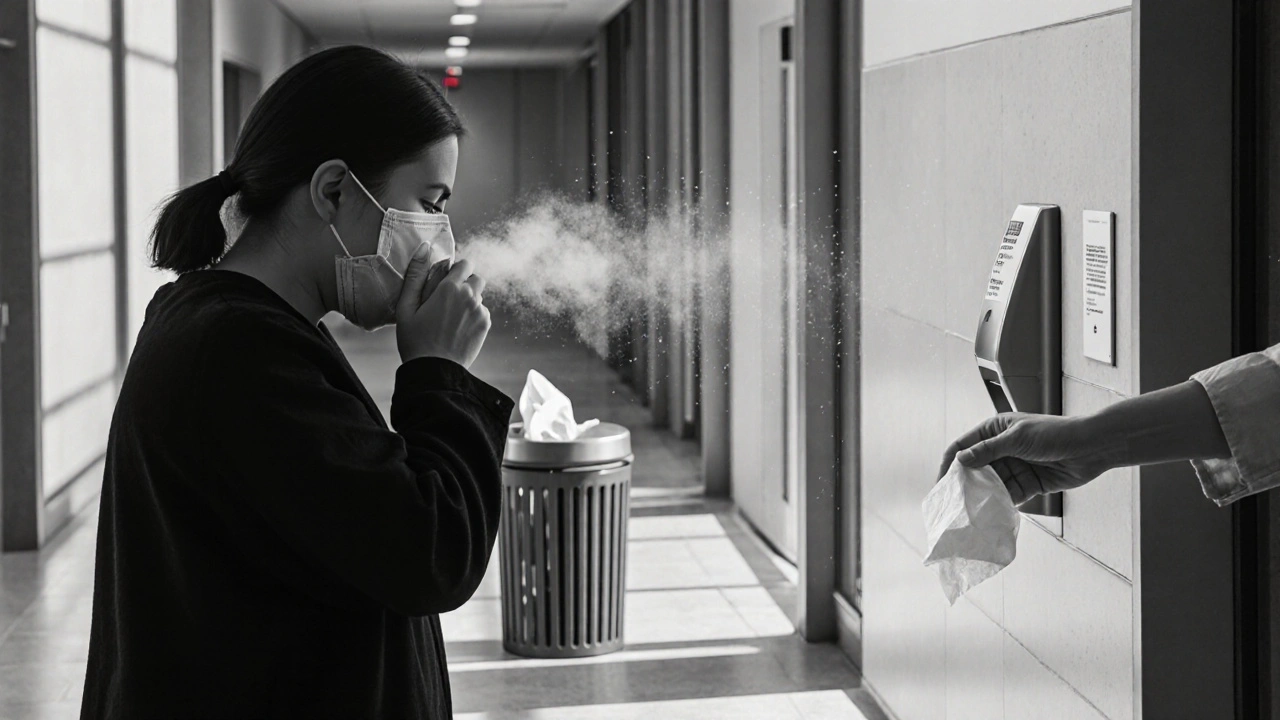When you feel a cough coming, the fastest way to protect those around you is to practice good cough etiquette. It’s a simple habit, but it stops germs from traveling on the air and landing on nearby people’s faces. Below you’ll learn why it matters, the exact steps to follow, and the common slip‑ups that can undo your good intentions.
Why covering your mouth makes a difference
Every time you cough, a cloud of respiratory droplets tiny particles of fluid expelled from the lungs and throat that can carry viruses and bacteria shoots out up to six feet. The droplets can linger on surfaces or stay suspended in the air for minutes, giving diseases like the flu, RSV, or COVID‑19 a chance to infect anyone who inhales them or touches them later. By blocking that spray, you shrink the distance germs travel and give people more time to avoid exposure.
The core steps of proper coughing
Think of the process as a three‑part routine: block, dispose, and clean.
- Block the spray. Use a clean tissue a disposable paper tissue designed for wiping the nose or mouth if you have one handy. If a tissue isn’t available, turn your elbow the inner part of the lower arm, which is less likely to touch surfaces toward your mouth and nose. Covering with your hand is the last resort-make sure you wash it right after.
- Dispose safely. Toss the used tissue into a lined trash can right away. If you used your elbow, simply move on to the next step.
- Clean your hands. Perform hand hygiene the act of washing or sanitizing hands to remove pathogens within 15 seconds. Either wash with soap and water for at least 20 seconds or apply hand sanitizer an alcohol‑based solution that quickly kills most germs on the skin containing at least 60% alcohol.
Choosing the right covering method
| Method | Effectiveness | Convenience | Risk of contaminating surfaces |
|---|---|---|---|
| Paper tissue | High - fully blocks droplets | Depends on availability | Low - disposable |
| Elbow (inner arm) | Medium - blocks most large droplets | Always available | Very low - arm rarely contacts public objects |
| Hand (palm) | Low - droplets can transfer to hands | Very high - hands are always there | High - hands touch doors, phones, etc. |
The table makes it clear why the tissue‑or‑elbow combo is the gold standard. A face mask can also serve as a barrier, but it should be used in conjunction with the steps above, not as a replacement.

Mask etiquette when you cough
If you’re wearing a face mask a cloth or medical‑grade covering that filters inhaled and exhaled air, keep it on while you cough. The mask catches most droplets, but you should still turn your elbow toward your mouth if the mask shifts. After coughing, replace the mask only if it becomes damp; otherwise, keep it on and follow the hand‑hygiene step.
Public health guidelines that back these habits
Worldwide health agencies such as the World Health Organization and the CDC have long recommended covering your mouth and nose when coughing or sneezing. Their public health guidelines official recommendations aimed at limiting the spread of infectious diseases stress that doing so reduces community transmission by up to 30% during flu season. The rules may sound simple, but they’re backed by decades of epidemiological data.
Common mistakes and how to fix them
- Using the hand and then forgetting to wash. Always set a mental alarm to clean your hands immediately after any cough.
- Holding a tissue in one hand and coughing into the other. Keep the tissue in the same hand that covers your mouth, then seal it quickly before discarding.
- Turning your head away while coughing. The direction of the cough matters; aim down toward your elbow or tissue, not outward.
- Neglecting to replace a damp mask. A wet mask loses filtration efficiency. Switch to a fresh one if it feels moist.

Putting it all together: a quick checklist for daily life
- Feel a tickle? Pause, and grab a tissue if you have one.
- If no tissue, bring your elbow up and cover your mouth.
- Dispose of the tissue immediately in a closed bin.
- Wash hands with soap for 20 seconds or use sanitizer.
- If wearing a mask, keep it on; replace only when damp.
- Stay aware of local health advisories and follow any extra rules.
Why you should care, even when you feel fine
Asymptomatic people can still spread infections. By using proper coughing etiquette, you protect vulnerable family members, coworkers, and strangers. The habit also signals respect-people notice when you’re considerate, and that builds a healthier community vibe.
Frequently Asked Questions
Can I cover my cough with a cloth napkin?
Yes, a clean cloth napkin works similarly to a tissue, but you must wash it after each use to avoid re‑contamination.
Is it okay to cough into my shirt?
Coughing into a shirt can trap droplets, but the fabric may later release them onto surfaces you touch. It’s better to use a tissue or elbow.
How often should I wash my hands after coughing?
Wash or sanitize immediately after each cough, especially if you used your hand to cover it.
Do masks replace the need for elbow‑covering?
Masks help, but they’re not airtight. Pairing a mask with elbow‑covering offers the best protection.
What if I’m in a crowded place and can’t find a tissue?
Use your elbow. It’s always there and keeps droplets from spreading into the crowd.

abhi sharma
October 15, 2025 AT 21:30Great, another cough guide-because we all forget how to use a tissue.
mas aly
October 16, 2025 AT 10:33Honestly, this is a solid reminder for anyone who’s been slacking on basic hygiene. Covering with a tissue or elbow is quick and keeps germs from spreading. The step‑by‑step list makes it easy to remember, especially in a rush. It’s the kind of practical advice that can actually lower infection rates in our daily lives.
Abhishek Vora
October 17, 2025 AT 00:26One must appreciate the thoroughness of this guide; it aligns perfectly with CDC recommendations and the WHO’s long‑standing advice. The distinction between high‑, medium‑, and low‑effectiveness methods is crucial, and the table conveys it succinctly. While many overlook the importance of immediate hand hygiene, this article emphasizes it correctly. It also correctly notes that masks complement, not replace, proper coughing etiquette. Moreover, the checklist at the end serves as an excellent quick‑reference for busy individuals.
maurice screti
October 17, 2025 AT 14:20Permit me to elucidate the epistemological significance of what might superficially appear as a mundane public health maneuver. The act of interposing a barrier-be it a tissue, the inner forearm, or a mask-constitutes a micro‑ritual of collective responsibility that transcends mere personal convenience. It is, in effect, an embodied negotiation between individual agency and societal welfare, a subtle choreography that orchestrates the flow of microscopic particulates within shared airspaces. When one employs a tissue, one not only arrests the ballistic trajectory of aerosolized droplets but also enacts a symbolic purge, consigning the contaminant to a disposable repository. Conversely, the elbow, ever‑present and unassuming, functions as a kinetic safeguard, leveraging anatomical topology to shield the nascent aerosol plume. To disregard these protocols is to tacitly endorse the stochastic diffusion of pathogens, thereby compromising the communal immune equilibrium. The inclusion of a mask, while ostensibly sufficient, merely augments the barrier matrix, reinforcing the multilayered defense strategy. Each component-tissue, elbow, mask, and subsequent hand hygiene-operates as an interlocking cog within a larger mechanistic system designed to attenuate viral transmission vectors. The author’s emphasis on immediate disposal further mitigates fomite‑mediated spread, a detail often eclipsed in cursory public advisories. In sum, this guide artfully synthesizes empirical data with pragmatic instruction, rendering it an indispensable addition to the public health canon.
Abigail Adams
October 18, 2025 AT 04:13While the prose is commendable, one must question the omission of practical constraints faced by lower‑income populations who lack consistent access to disposable tissues. The reliance on a single‑use paper product, although effective, introduces environmental considerations that warrant discussion. Additionally, the guide could benefit from a more explicit acknowledgment of cultural variations in cough etiquette. Nonetheless, the overall structure is rigorous and the recommendations are well‑substantiated.
Belle Koschier
October 18, 2025 AT 18:06I think this guide strikes a good balance between detail and clarity. It acknowledges the reality that we don’t always have a tissue handy and offers the elbow as a reliable fallback. The checklist at the end is especially handy for quick reminders. It’s a thoughtful piece that can help keep everyone safer.
Allison Song
October 19, 2025 AT 08:00From a philosophical standpoint, the practice of covering one’s cough can be seen as an embodiment of the social contract. By taking a small moment to protect others, we reinforce mutual trust and communal well‑being. It’s a simple act that carries profound ethical weight.
Joseph Bowman
October 19, 2025 AT 21:53Look, there’s a whole hidden agenda behind these “public health” kits. They want us to rely on disposable tissues so they can profit off the endless production chain. If you think about it, the real solution is to wear a reusable mask and just keep your hands clean, not get sucked into a consumerist trap. Also, the guide never mentions how the government monitors the waste from all those tissues. Stay alert, stay skeptical, and think for yourself.
Singh Bhinder
October 20, 2025 AT 11:46Just a quick note: it’s good to have the elbow option when you’re in a pinch.
Kelly Diglio
October 21, 2025 AT 01:40The guide does a commendable job of breaking down the steps in an approachable manner, yet there are nuances worth highlighting. For individuals with dermatological sensitivities, frequent handwashing may exacerbate skin irritation; thus, a gentle, fragrance‑free soap is advisable. Moreover, the recommendation to use an alcohol‑based sanitizer should be tempered with a reminder that concentrations below 60% are less effective. In crowded settings, the timing of disposal matters-immediate placement of used tissues into a covered bin minimizes aerosolization. The inclusion of mask etiquette is particularly pertinent given the resurgence of respiratory illnesses this season. Lastly, for those caring for immunocompromised family members, strict adherence to the protocol can be lifesaving. Overall, the article serves as a solid foundation, but these additional considerations can enhance its practical utility.
Carmelita Smith
October 21, 2025 AT 15:33Nice reminder! 😊
Liam Davis
October 22, 2025 AT 05:26Indeed!; the steps are clear-cover, dispose, sanitize; this triad forms a robust barrier against pathogen spread; remember to wash for at least 20 seconds, not just a quick rinse; using a tissue reduces surface contamination, while the elbow method eliminates reliance on potentially contaminated hands; keep your mask dry, and replace if damp; these practices, when consistently applied, can dramatically lower transmission rates; stay vigilant! 😊
Arlene January
October 22, 2025 AT 19:20Let’s keep the momentum going! Every cough covered is a win for the community-small actions add up to big results.
Kaitlyn Duran
October 23, 2025 AT 09:13Totally agree, staying mindful makes a difference.